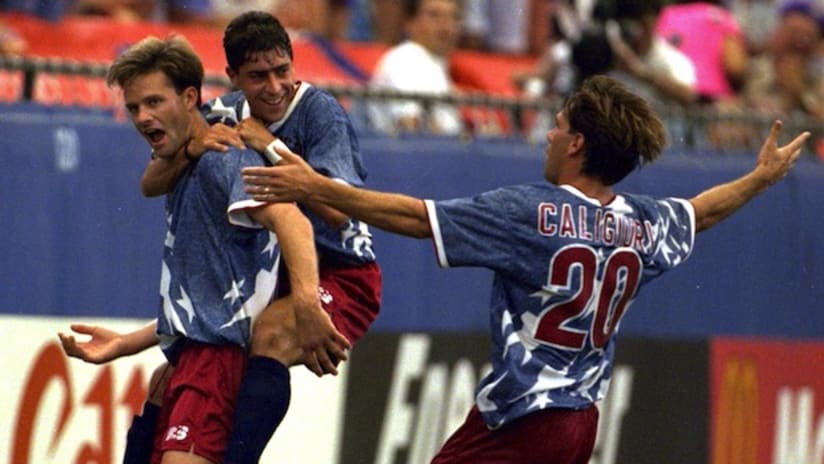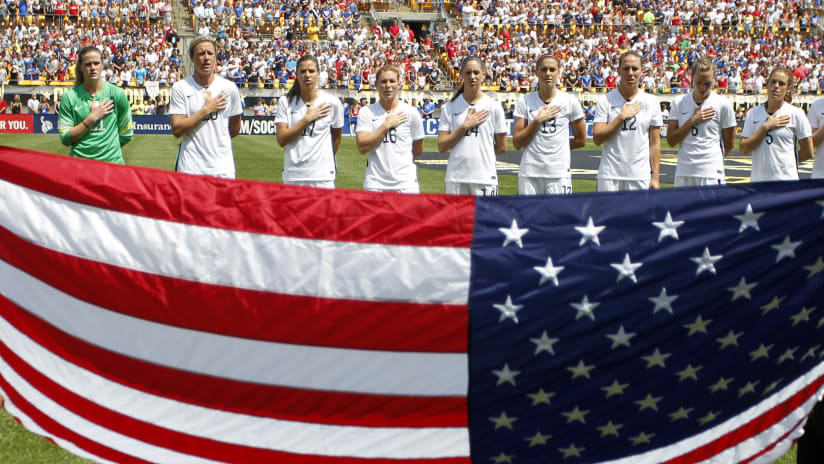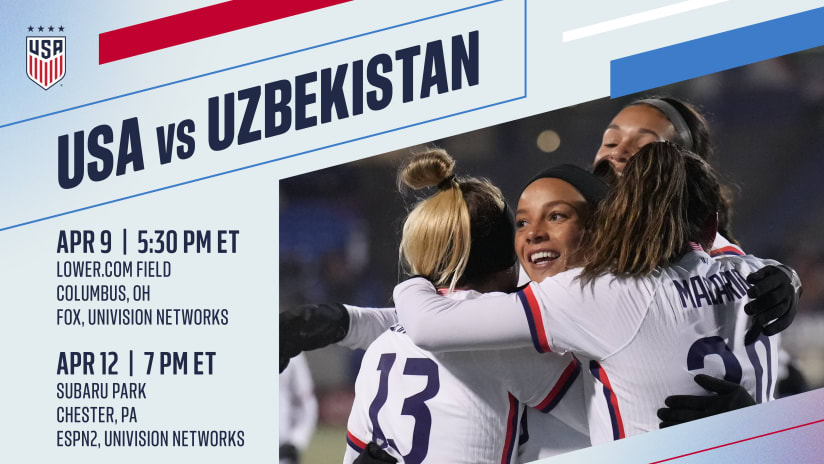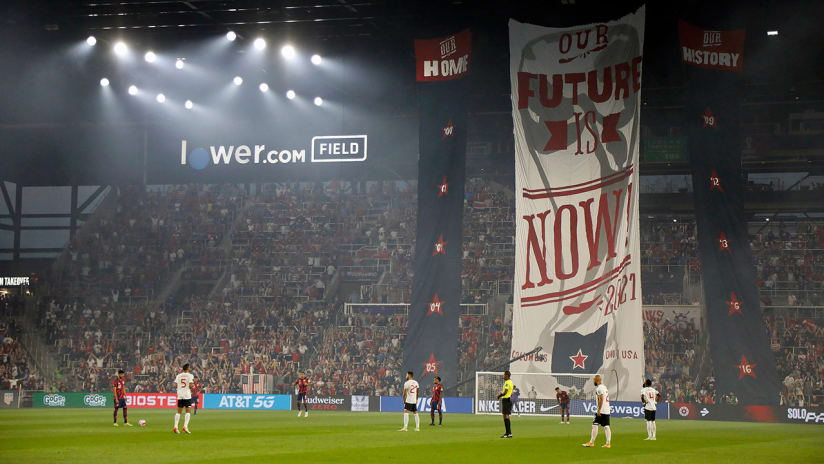With an average age of just under 28 years old, it’s likely that no current members of the United Stated Men’s National Team at the 2014 FIFA World Cup have memories of a point in history in which the U.S. was not at soccer’s forefront.
The U.S. failed to qualify for the World Cup from 1954 to 1986, and the collapse of the first incarnation of the North American Soccer League left America without a topflight soccer league.
But with the United States’ hope of hosting the 1994 FIFA World Cup reportedly in question, one goal in Port of Spain, Trinidad in 1989 changed everything.
The U.S. qualified for the 1990 tournament and hosted the 1994 Cup without a hitch to record crowds, Major League Soccer was born and a generation of U.S. soccer players was invigorated and inspired to pursue professional soccer and play in the world’s most prestigious competition.
As part of TheCrew.com’s Black & Gold on Brazil content series, the Crew’s Josh Wolff, Frankie Hejduk and Gregg Berhalter share their memories of the First Generation of the modern U.S. Men’s National Team.
*
Growing up in the Atlanta suburb of Stone Mountain, Georgia, soccer was very much an afterthought for the youth of the area like current Crew Assistant Coach Josh Wolff. A hotbed for football, basketball and football, soccer was more of a recreational activity for youngsters to burn-off energy.
“[Soccer] was developing,” says Wolff. “There was still youth soccer, but soccer was very far back considering the other sports. It was more of a thing kids did when they were just little kids, [ages] six-10. You have football, baseball and basketball; there was no visibility [of soccer] on TV.”
Wolff continues: “Occasionally, you'd have some highlights from around the world and anytime the World Cup came around you'd obviously have games on TV. Your exposure to the sport, your exposure to the game globally was very minimal. It was a reflection of where we were 20-something years ago.”

In the other sports, Georgians had the flash of Deion Sanders of the Atlanta Falcons and the “Human Highlight Reel” Dominique Wilkins of the Atlanta Hawks to look up to 25 years ago. For Wolff, there were very few role models in soccer before the 1990 World Cup and a career in professional soccer was practically unthought-of.
“The National Team had such limited visibility, I don't know that I had really any recognition of who our players were until you saw them at the World Cup in '90 and obviously in '94,” he reflects.
But then, with the USMNT’s qualification in the 1990 FIFA World Cup in Italy, and the United States’ subsequent hosting of the 1994 World Cup came a flurry of budding stars that provided the dream of pursuing a career of playing soccer.
“You saw the [Eric] Wynaldas, the [John] Harkes, [Roy] Wegerles,” Wolff recalls. “To me, those were guys that were kind of the frontline guys for U.S. Soccer back then. Then Cobi Jones, [Marcelo] Balboa and [Roy] Lassiter, they're the names of who came through the ranks in those early years when soccer was still trying to make a footprint. It was such small amount of exposure of them and the game, it's tough to reflect back on those times because there just weren't many memories until you hit the '90 World Cup and the '94 World Cup.
“I don't think pro soccer became a reality until we got the World Cup bid for the '94 World Cup, and then part of that was that we'd form a League and have something starting in '96.”
Watching the World Cup in the States in 1994, Wolff was determined to work hard as a standout forward in high school to pursue the dream of playing in the sport’s most prestigious tournament one day. The striker eventually earned a scholarship to the University of South Carolina, with a future in MLS in his sights.
“I remember being in high school, I went to the World Cup,” Wolff says. “I was at the game where the U.S. beat Colombia in LA. That's when the memories are really etched as far as soccer and some of the other experiences that I started to have.”
He continues: “When I was in high school and the League all of a sudden had the backing, then you started to really focus on it and I was going to college [to play soccer].
“You didn't know how it was going to play out, but you were certainly excited that there was going to be professional soccer in our country.”
After three seasons at South Carolina, Wolff signed with MLS where he would score 80 goals in 14 seasons with the Chicago Fire, Kansas City Wizards and D.C. United while winning 52 caps and scoring nine times for the USMNT. Wolff represented his country at the 2002 and 2006 FIFA World Cups, scoring a monumental goal to help the U.S. to its first "Dos a Cero" victory over Mexico at Crew Stadium in a 2002 FIFA World Cup Qualifier on February 28, 2001.
On the other side of the country in San Diego, California, a young Frankie Hejduk excelled at his hobbies of soccer and surfing. Without a professional league or National Team prominence, soccer was just that for the future Crew and USMNT legend during the late 1980s: a hobby.
“I just played soccer and there weren't a lot of role models to look up to,” the laid-back two-time World Cup veteran recalls. “You just played the sport itself. Back then, it was just more of something you had fun doing. To be honest, at that point I don't think I was looking into as a career. It was more of a hobby and something fun that I did.”
Hejduk goes on: “I actually surfed a lot more than I played soccer in those times. I loved the sport more than anything; there just wasn't a huge emphasis on being a professional soccer player at that time. There wasn't a League, there weren't people to look up to.”
For Hejduk, the semi-arid climate of Southern California provided him year-round access to both of his hobbies. The Golden State helped him and many others in the area hone their soccer skills, providing a pipeline of youth soccer talent at the time.
“Soccer in Southern California is great, because you can play outdoors all year long,” he recalls. “Here in Ohio, you have to come indoor for three months of the year or whatever, where as in San Diego, you're always able to play the game outside no matter what. In that way there was a little bit of an advantage.”
Though he was also a state champion surfer, Hejduk’s soccer talent provided him an opportunity to go to college and play the sport. As a student-athlete playing for Sigi Schmid at UCLA, Hejduk's imagination was captured by the 1994 FIFA World Cup played Stateside and a future of making a living in the sport started to become a reality.
“The 1994 World Cup, that's when the buzz about soccer really came in America,” he says. “I think you saw the potential of the sport, and no one knew the potential of soccer in America. A lot of people saw it and said, 'Whoa. We're selling out every single game?' They were selling out even the games people wouldn't normally want to watch, but now there's 80,000 people watching it. I think at that time, everyone realized.”
Just two years later, Hejduk would play in Major League Soccer’s inaugural season for the Tampa Bay Mutiny and represent the U.S. at the 1996 Summer Olympics in Atlanta. The rest, as they say, is history as Hejduk earned 85 caps with the USMNT as a key cog in the country's 1998 and 2002 Cup efforts. After several UEFA Champions League appearances with German giant Bayer Leverkusen, Hejduk returned to MLS to play for the Crew. The eventual Crew Captain led the Black & Gold to three MLS Supporters' Shields and the 2008 MLS Cup during his time as a player in Columbus.
Unlike Hejduk and Wolff, Crew Sporting Director and Head Coach Gregg Berhalter was immersed in soccer growing up in the multi-cultural community of Tenafly, New Jersey. Berhalter recalls watching the 1986 FIFA World Cup played in Mexico and the USMNT’s qualifying for the 1990 tournament, though soccer was rarely covered by the mainstream media.
The moment that changed it all for Berhalter – as it changed the American soccer landscape forever – was Paul Caligiuri’s “Shot Heard ‘Round the World” on November 19, 1989 to lift the U.S. to its first World Cup appearance since 1950.
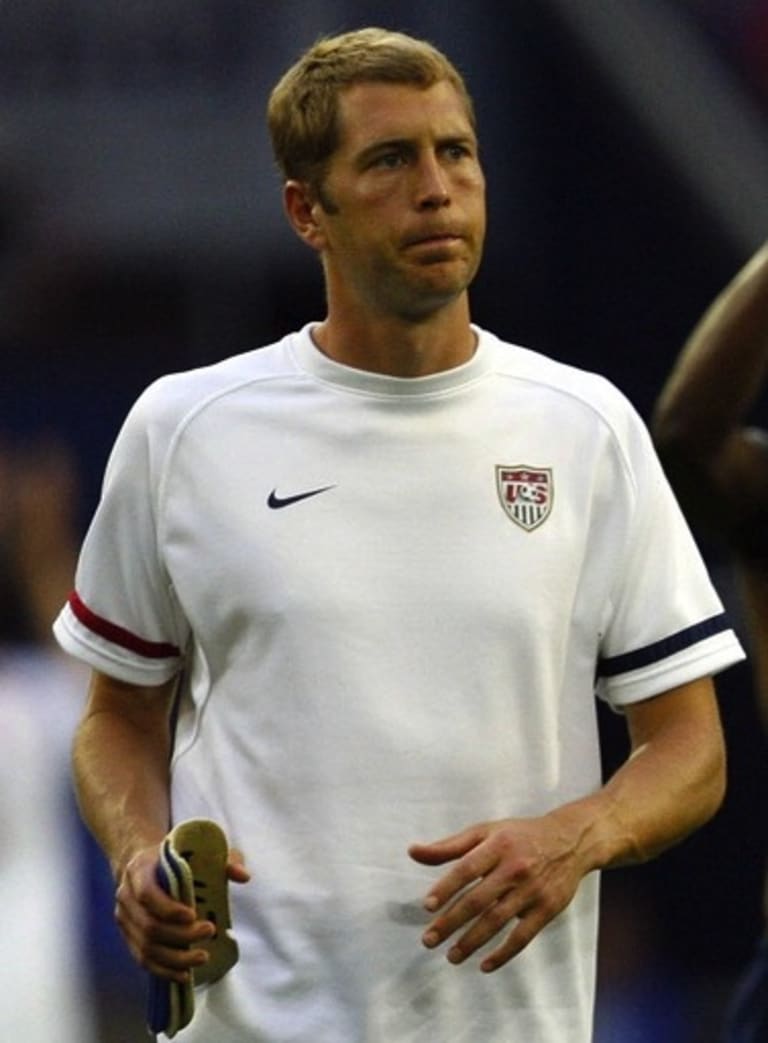
“There wasn't much coverage, in terms of television,” Berhalter says. “I remember brief moments of the coverage. I remember Steve Trittschuh scoring on a volley in one of the Cup Qualifiers in Saint Louis, and that was something that was amazing.”
He continues: “Then the game in Trinidad when Paul Caligiuri had the goal, that's something I remember very clearly. [The USMNT] was being covered and they qualified. Right around there was when my interest was starting to peak and I was getting fully involved. The first World Cup I watched was 1986. Growing into '90, I was fully involved. I knew a lot of the players; I knew a lot of the teams. It was great watching the 1990 World Cup.”
Many of the members of the United States’ 1990 World Cup team hailed from New Jersey, including Tony Meola, John Harkes and midfield maestro Tab Ramos. The local talent showcased a path that one day Berhalter would choose to follow.
“They were the ones that stood out from that group,” he says. “There were a lot of quality players [in New Jersey] at that time. If you look now, there are a lot of coaches from that area and younger National Team players. That 10-year or maybe eight-year window was really big in New Jersey and developing players.”
Berhalter goes on: “Tab [Ramos] went to my high school, and [John] Harkes and [Tony] Meola were from Kearny, which is right there. We knew about these guys. We knew what they were doing and we got to see them live. We got to play against them when Tab would come back to high school. I don't think I necessarily equated those guys with pro soccer because that was the National Team and pro soccer was what I saw on TV watching Italian soccer on Sunday.”
On the cusp of his first professional experience in Holland, the U.S.-hosted 1994 FIFA World Cup provided Berhalter a chance to experience World Class soccer up close with matches played at Giants Stadium in nearby East Rutherford, N.J.
“I was watching as many games as I could on TV and going to the stadiums and watching the games,” he recalls. “The atmosphere was amazing; the stadiums were amazing. It was really a great spectacle, a great show.”
Following the 1994 World Cup, Berhalter signed his first professional contract with Zwolle in Holland to begin a 16-year playing career that would take him to Germany, England and back to the United States. The defender won 44 caps for the Stars and Stripes, while representing the U.S. at the 2002 and 2006 FIFA World Cups.
*
The impact of the United States’ qualification for the 1990 World Cup is undeniable. Future Crew midfielder Paul Caligiuri’s landmark goal in Trinidad kick-started a revolution in American soccer, spawning a League and a National Team that would turn into a power in CONCACAF, the country’s FIFA region.
“It's amazing,” Berhalter says. “I don't think you realize how much impact one shot, one movement can have on soccer. I think it had a huge impact. [Caligiuri's] shot started it; it started the momentum. It got the ball rolling.”
Though the U.S. failed to earn a single point in Italy at the 1990 tournament, Caligiuri’s effort to book the USMNT’s ticket laid the groundwork for the 1994 FIFA World Cup, the country’s future success on the international stage and Major League Soccer.
“The dominos of [Caligiuri’s goal]: participating in the 1990 World Cup, hosting the World Cup in 1994 and qualifying for every World Cup since then -- and a League,” Berhalter said. “It started a lot of great stuff for soccer in America and I think it's only going to continue to grow.”
While Caligiuri’s shot was the catalyst, the 1994 FIFA World Cup took U.S. Soccer to the next level and inspired many, including Berhalter, Hejduk and Wolff to follow their dreams to play in a World Cup. Twenty years later, the ripples are still being felt from the 1994 tournament being held on U.S. soil.
“When you have the event -- the World Cup -- in the United States, because we're such a powerful, prominent country and not a soccer country, now you put us in the limelight,” Wolff says. “You put our country on the frontlines of media and sports, and now visibility. It really amped up the thirst for soccer. It's taken a long time for the sport to grab roots here, but that was a massive movement for the game. You get the like of all sorts of people -- people who that don't follow soccer getting into the sport finally, media coverage that probably was never there.
“It's taken a long time to get to where we are today, but that was a very, very big moment for our sport in our country and for all of us, for that matter.”
